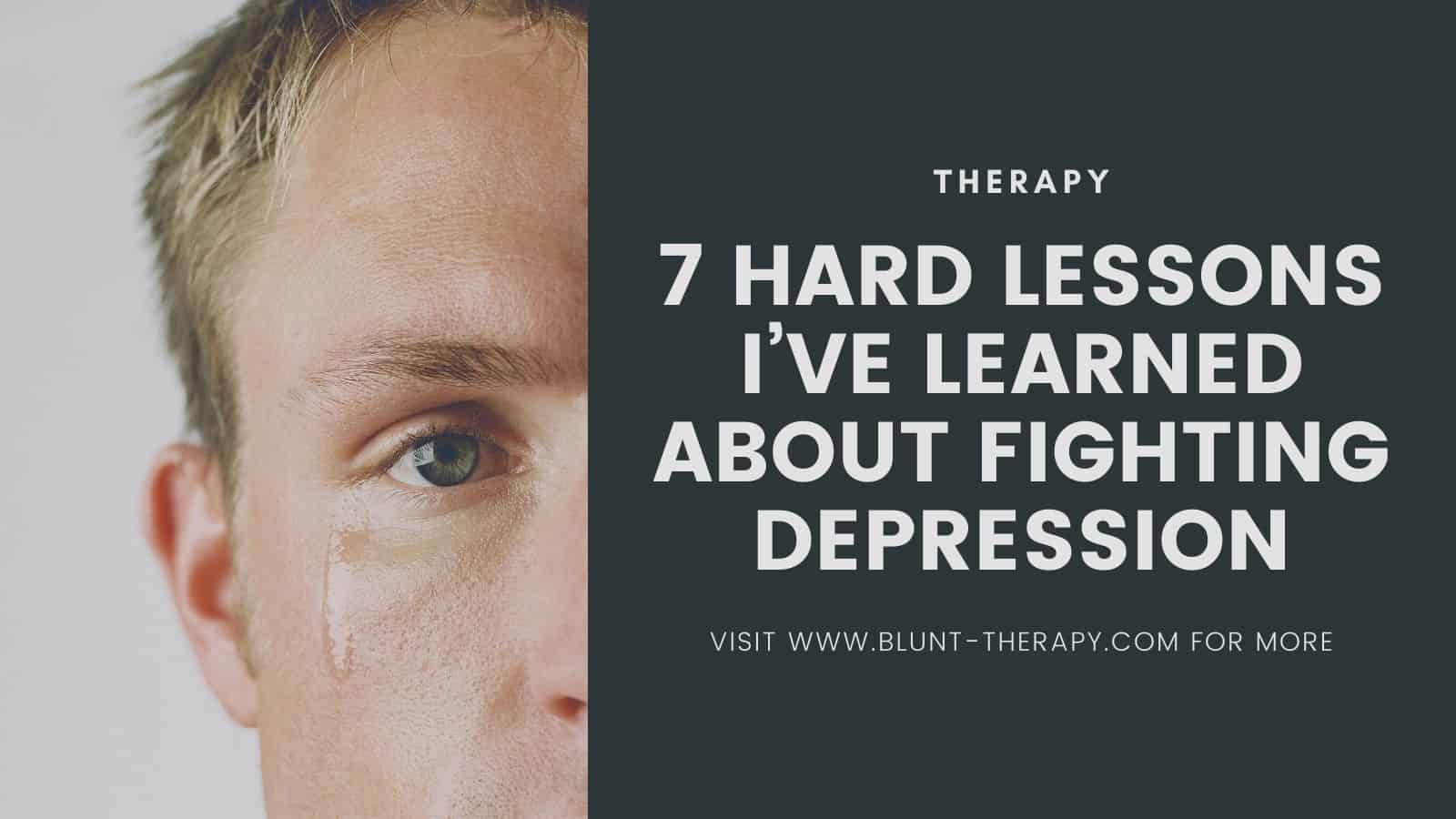Table of Contents
Affiliate link notice: As an affiliate of BetterHelp and other third-party vendors, We will receive compensation if you make a purchase using the links provided on this page. For more information, visit our disclosure page.
Last Updated on December 12, 2021 by Randy Withers, LCMHC
In the war for suicide prevention, mental health professionals have served on the frontlines for decades.
In hospitals, treatment facilities, and in private practice, therapists, psychologists, and psychiatrists routinely deal with patients who struggle with suicidality, which the American Psychological Association defines “the risk of suicide, usually indicated by suicidal ideation or intent, especially as evident in the presence of a well-elaborated suicidal plan.”

Many of these patients have attempted suicide in the past. Many more struggle with suicidal ideation daily.
As such, it is important to hear what these therapists have to say.
To write this post, I interviewed psychiatrists, psychologists, and therapists from across America, from California to Connecticut, from Arizona to Illinois.
They shared their thoughts on suicide and suicide prevention to provide their perspective and to spread awareness, not solely on the tragedy of suicide but also about the treatability of it.
The Prevalence and Scope of Suicide
In the United States, suicide is the 2nd leading cause of death among those aged 10 to 34.
In 2018, 48,344 Americans died by suicide. An additional 1.4 million made suicide attempts.
If you are American, chances are someone you love has struggled with suicidal thoughts, attempted or died by suicide, or known someone who has.
The number of suicides and suicide attempts annually in America has risen steadily over the past decade. In 90% of these cases, the individual had a diagnosable (but treatable) mental illness.
Chief among these is depression, an insidious and dangerous disorder that affects more than 20 million Americans annually.
The COVID-19 Pandemic, of course, has made matters worse. Massive layoffs, school closures, hundreds of thousands of deaths, and economic instability have triggered an alarming increase in mental illnesses that strongly correlate with suicidality.
In June 2020, the Centers For Disease Control conducted a survey in which they compared the rates of substance abuse and other mental health conditions during the first quarter of 2020 to the first quarter of 2019. The results of their findings are as follows:
- The prevalence of symptoms of anxiety disorder was approximately three times those reported in the second quarter of 2019 (25.5% versus 8.1%)
- The prevalence of depressive disorder was approximately four times that reported in the second quarter of 2019 (24.3% versus 6.5%)
- Approximately one quarter of respondents reported symptoms of a trauma or stress-related disorder (TSRD) related to the pandemic
- Approximately one in 10 reported they started or increased substance use due to COVID-19.
- Approximately twice as many respondents reported serious consideration of suicide in the previous 30 days than did adults in the United States in 2018 (10.7% versus 4.3%)
As this post was written in January 2021, we do not yet know what long-term effects COVID-19 will have on suicide rates in the United States, but the data collected so far is worrisome.
Even before the Pandemic, suicide was the 10th leading cause of death in the United States. More people die by suicide than from opioid overdoses, auto accidents and homicide.
| Homicide | 18,830 |
| Auto accidents | 36,835 |
| Opioid-related overdoses | 46,802 |
| Suicide | 48,344 |
“Suicide is unquestionably an epidemic that does not discriminate by age, gender, race, ethnicity, or sexual identity,” says Dr. David Pfaff, PhD, LPC, a psychotherapist in Oklahoma City. “It is also highly stigmatized and misunderstood. We do not talk about suicide enough publicly and all too often when we do, we spread myths and negative stereotypes.”
But facts and figures only tell part of the story.
The true cost of suicide is impossible to measure. Loss, heartache, and grief cannot be quantified or graphed. Often, they can only be experienced and endured.

Therapists Share Their Thoughts on Suicide and It’s Effects on Survivors
Suicide is devastating on many levels. When a person feels like they have no other option, suicide can seem like the only way to avoid more pain.
Yet the tragedy of suicide is rarely limited to one individual.
“Family members who have died by suicide increase a person’s risk level for suicide,” says Elaine Hixson-Weiss, MC, LPC, the Associate Clinical Director of the mental health facility Sierra Tucson.
In addition, loved ones often struggle with complicated grief. As William Schroeder, LPC, the Co-Director of Just Mind Counseling notes, suicide “leaves a lack of closure that can easily feel like a curse to the survivor.”
The shocking nature of the act tears families apart and can trigger a host of mental illnesses in individuals, including anxiety, depression, and post-traumatic stress.
For the loved ones of a person who has died by suicide, says therapist Rita Richards, LCSW, “Letting go after suicide is nearly impossible.”
As such, the ripple effect of suicide can last for generations.
In interviews with more than two dozen mental health professionals, most of them emphasized the negative consequences of suicide with respect to family, friends, and loved ones.
Therapists are often the first ones to learn of a patient’s struggles with suicidality. Collectively, they deal with the fallout of suicide more than anyone should ever have to.
“I always say to my patients who think about suicide that they need to know that they are cursing their loved ones for their entire lives,” says Dr. Mark Rego, MD, a psychiatrist at Yale University School of Medicine. “They will never get over it. People make progress, but they never fully recover.”
Often, loved ones are left to struggle with questions about which they will never get answers. “It affects them because the ‘why’ question never goes away,” notes Dr. Jerry Opthof, PsyD.
“Suicide is often so charged that people have a hard time processing it and thus they avoid doing so,” says Schroeder. They never address the trauma, the effects of which then get passed on to their kids. This can lead to greater incidence of substance use, eating disorders, and problems in relationships.
Children, too, have a difficult time coping with the after effects of suicide, especially when one of their parents has died by suicide. As psychologist Lisa S. Larsen, PsyD points out: “Children do not have the adult understanding and knowledge that help adults cope.”
Regardless of age, the loss of a loved one to suicide is devastating. Family members frequently report strong feelings of guilt and despair. According to therapist Shari Botwin, LCSW, author of Thriving After Trauma: Stories of Living and Healing “Many loved ones will say ‘I should have known,’ or ‘What if it was my fault?’ or ‘How could he/she leave me like this?’”

Inside The Mind of A Person Struggling With Suicidality
For most of us, suicide is a subject shrouded in mystery. People who have never struggled with mental illness have a particularly hard time understanding why anyone would want to take their own life.
To complicate matters, on the rare occasion news media outlets cover a suicide, it is often a celebrity. Anthony Bourdain comes to mind, as do Margot Kidder and Robin Williams.
Many of us cannot help but wonder why these people chose to die by suicide. They had money. They had fame. They had so much to live for.
And while those statements may be true, suicide is almost never about reality. It is about a skewed perception of reality.
Impulsivity and rapid onset of suicidality are often factors. Sometimes, suicide happens with almost no warning.
“Some people kill themselves with no known history of psychiatric problems,” notes Dr. Mark Rego, M.D.
For those who die by suicide, we will never know what happened. We rarely know their motivations. We rarely understand their thinking.
But what we can do is read the words of mental health professionals who specialize in trauma and who have worked with hundreds of suicidal patients over the years.
In this section, therapists respond to the question – what goes on in the mind of a suicidal patient?
Dr. David Pfaff, PhD, LPC – Licensed Professional Counselor
Suicide is a universal part of the human condition. I would argue that every adult on this earth has had a suicidal thought. And these thoughts scare the hell out of us, so we do not talk about it out of fear of what we think about ourselves and what others would think of us for having those thoughts.
But part of what makes suicide part of the universal human condition is it is not being crazy, messed up, screwed, up or any of the other negative and stigmatizing terms that get thrown around. It is because human beings are wired, like all other beings, to avoid or remedy our pain. Suicide is a way to do that.
Someone experiencing suicidality is not crazy. They are in overwhelming and blinding emotional pain. Moreover, the pain is often not something that you can see, or even understand. You just know you want it to stop.
Suicide begins to make sense as a coping mechanism to make this pain end. What is more, this pain often comes with negative self-narratives and depression. Thoughts become less clear, confusing, and muddied.
The person begins to believe that the world would truly be a better place without them. They see themselves as a burden and, at times, selfish for not relieving the world of this burden.
In essence, suicidal thoughts are like blinders that limit our view of the world and ourselves. We begin to get tunnel vision and fixated, all the while our field of vision is skewed.
People may tell them that they are selfish, a sinner, or going to Hell, but what they do not realize is the person may already believe this, and those comments only cement their negative beliefs.
Dr. Mark Rego, M.D. – Psychiatrist at Yale University
Although many people commit suicide, it is uncommon compared to the number of people who feel suicidal. I know of no number to put on this except to say that over 25 years I spoke to patients about it daily. Women both feel suicidal and make suicide attempts more than men, but men die more from suicide because their attempts are more violent.
Next come more active thoughts. These are actual thoughts about wanting not just to die but to kill yourself. It begins with just that thought, ‘I want to kill myself,” and goes up into plans.
Once a patient thinks her family will be better off without her, she has passed a dangerous threshold.
Depression is usually the reason for suicidal thoughts. But almost any psychiatric condition can bring them on.
Suicide is not a response to mental pain as often thought. It is a psychiatric condition in itself.
Many patients have told me that they can feel worse after a break up or job loss than when they were suicidal (and conversely, feel suicidal at the initial stages of a depression).
So feeling ‘very bad’ is not the reason for suicide as people feel ‘very bad’ all the time and never give a thought to suicide.
Elaine Hixon-Weiss, LPC, Associate Clinical Director for Sierra Tucson
Some people do not want to die yet are not sure how to continue living with the amount of pain and suffering they are experiencing.
It is hard to help a person in so much emotional pain and turmoil to consider that this feeling will pass with some time as they are feeling so much that it does not seem bearable for even another moment.
Jason Drake, LCSW-S, Owner and Lead Clinician at Katy Teen & Family Counseling
Those who commit suicide do not want to die. They are searching for a way to live and a way to live without the pain of depression.
Many who suicide have tried repeatedly to get help without success for one reason or another.
Suicide is the last option in their mind to make the pain go away.
Shari Botwin, LCSW, Author of Thriving After Trauma: Stories of Living and Healing
Usually people who contemplate suicide feel trapped. They feel hopeless and are unable to describe their feelings. Many feel like it is the only option.
They do not see hope and usually feel disconnected. They think things like “no one understands.”
Some people with suicidal tendencies have a history of earlier trauma. Suicidal tendencies are a symptom that manifests as a result of flashbacks or memories from abuse or sexual assault or tragic losses they suffered earlier in life.
Arien Conner, LCSW, of Clear Path, LLC
While people who die by suicide have traumatic events in their past, many do not.
People who commit suicide are struggling with something internally that they can’t accept and/or don’t see a way out of. They feel stuck in a dark, lonely place that they are probably struggling to put into words and talk with others about.
They struggle to find hope or see any possibility of a different outcome in the future. They often think of themselves as a burden, and they don’t want to be that or feel that way anymore. This contributes to the secrecy of suicidal thoughts.
William Schroeder, LPC, Co-Director of Just Mind Counseling
What goes on in the mind of a suicidal person varies, but it’s often feeling pretty boxed in. Often this isn’t the reality, but it’s how they feel. Sometimes this is due to gender or sexuality and people have fear of the repercussions of the path forward and reactions or the reality.
Clients with bipolar or complex trauma may also encounter times when they are suicidal. Bipolar is challenging due to the crushing depression that clients can face, but the right medication and treatment regimen can go a long way to prevent and alleviate suffering.
It’s hard when people are in the throes of those difficult moments, though, as they may last some time and can be accompanied by job loss, insurance loss, and/or loss of other emotional support mechanisms.
Complex trauma, like someone who was repeatedly abused as a child, can similarly bring about similar bouts of depression or suicidality.
The good news here is that sometimes the suffering can be so challenging that people try something new – a new therapy, treatment, medication, support group, etc. Complex trauma is challenging and can take time to undo, but it also can shift and resolve over time.
The Co-Morbidity of Major Depression and Suicide
Suicidality is often a co-morbid feature of Mood Disorders, including Bipolar Disorder, Major Depressive Disorder, and Persistent Depressive Disorder (Dysthymia).
If you ask a therapist about their thoughts on suicide, the discussion invariably turns to Major Depressive Disorder.
Many, if not most, people with depression have some suicidal thoughts,” notes Dr. Mark Rego, M.D. “There is a range of what we call suicidal ideation. This is having thoughts like “I’d be better off dead,” or “life is too hard, I wish I could go to sleep and never wake up.”
Depression is incredibly common. Yearly, some 17.3 million adults and 3.2 million adolescents aged 12-17 struggle with at least one major depressive episode. This, according to research published by the National Institute of Mental Health (NIMH).
For a diagnosis of Major Depressive Disorder, at least 5 of the following criteria must be present for at least two weeks.
- Depressed mood—indicated by subjective report or observation by others (in children and adolescents, can be irritable mood)
- Loss of interest or pleasure in almost all activities—indicated by subjective report or observation by others.
- Significant (more than 5 percent in a month) unintentional weight loss/gain or decrease/increase in appetite (in children, failure to make expected weight gains).
- Sleep disturbance (insomnia or hypersomnia).
- Psychomotor changes (agitation or retardation) severe enough to be observable by others.
- Tiredness, fatigue, or low energy, or decreased efficiency with which routine tasks are completed.
- A sense of worthlessness or excessive, inappropriate, or delusional guilt (not merely self-reproach or guilt about being sick).
- Impaired ability to think, concentrate, or make decisions—indicated by subjective report or observation by others.
- Recurrent thoughts of death (not just fear of dying), suicidal ideation, or suicide attempts.
Note: If you believe you struggle with depression, it is important that you see a licensed mental health professional for accurate diagnosis and treatment.
While most people who struggle with depression never attempt suicide, 60% of people who die by suicide had a diagnosable mood disorder. Chief among these is depression.
There are many factors that contribute to a person becoming depressed,” says Dr. Anjani Amladi, M.D., a Board Certified Psychiatrist. “Genetics, psychology, brain chemistry, chronic medical conditions, pain, environmental circumstances, inadequate nutrition, etc. can have an impact on whether someone develops depression. The bottom line is that depression is not a choice.”
Major Depressive Disorder is serious. It is pervasive, insidious, and potentially deadly.
If you struggle with depression, you need to know that people can and do recover, but usually not on their own. “Major Depressive Disorder usually does not pass without professional support,” says Jason Drake, LCSW-S.

Therapists Share Their Thoughts on Suicide Prevention
Therapists are in a unique position to comment about matters related to suicide prevention. They deal with suicidality daily.
In terms of support and awareness, they also know that far more can be done to prevent suicide, especially with adolescents and teens.
Thoughts on suicide and suicide prevention vary by individual, but as with depression, common themes emerge.
These include the role of family, portrayal of suicidality in popular media, and what schools (and the rest of us) can do to educate children.
Suicide prevention begins with suicide awareness. And an important part of suicide awareness is education about suicide and the mental illnesses that frequently co-occur.
Thoughts On The Role of Parents and Family
Dr. Fran Walfish, PsyD, a Psychotherapist and Author in Beverly Hills, CA, has worked with hundreds of children who struggle with suicidal thoughts and actions.
“I have seen a rise in numbers of troubled teens who are cutters and dealing with suicidal thoughts, feelings, ideas, plans, and even attempts,” she says. “The one common denominator shared by all kids and teens (and adults) who cut, contemplate or attempt suicide is they feel emotionally alone in their families. They feel there is no one person they can talk to about their pain who will listen, validate, understand, and be a safe, warmly attuned place for comfort.”
Parents should take the threat of suicide seriously and implement a Personal Safety Plan that includes interventions that have worked in the past, warning signs, and contact information for crisis support.
Ideally, families should serve as the first line of defense.
One way parents can help is by fostering a nurturing and supportive environment where children are encouraged to talk about their problems, no matter how severe.
Parents should talk openly not only about suicide, but about mental health as well, notes Dr. Jerry Opthof, PsyD.
Julie Fanning, LCSW, also warns parents about acknowledging the reality of suicide and the dangers of making assumptions. “Family and friends shouldn’t assume that because someone has lived through an attempt or has stopped talking about it that they are no longer thinking about it, she says. “The thoughts may not be forever, but they don’t go away immediately.”
For the parents of teenagers, recognizing depression and suicidal ideation is especially challenging.
“Teens today are better able to hide symptoms of depression, says Jason Drake, LCSW-S. “When most of their socializing is spent online, particularly during the pandemic, parents are not privy to verbal communication as they have been before.”
While so-called “teen-angst,” is common, parents should be wary of dismissing clinical depression as a byproduct of a developmental stage.
“For parents,” notes Drake, “it is important to err on the side of safety. If there is concern that their teen may be depressed, seeking help from a professional can make all the difference. Seeing their pediatrician or a therapist can help determine if it is depression or if it may be merely a phase.”
He goes on to state that parents should normalize the subject of mental health beginning in elementary school. Doing so prepares kids to talk about things like depression and suicide when they become teenagers.
One of the best things a parent can do is educate themselves on depression and suicidality. “Parents who are not educated about depression and mental illness may not recognize that suicidal thoughts are a symptom of a deeper issue,” says Shari Botwin, LCSW.

Thoughts on Suicide As Depicted In Popular Media
There is nothing glamorous about suicide.
However, any time a controversial subject is portrayed in popular media, it runs the risk of glamorizing what it seeks to condemn.
In 1996, the movie Trainspotting portrayed the torture of heroin addiction; it ended up creating what The Washington Post dubbed “A Menacing Allure.” In 1998, Steven Spielberg’s Saving Private Ryan tried to capture the horrors of 20th Century warfare; it ended up ushering in a wave of gory combat-related video games and movies that are now an industry norm.
In recent years, television has tackled the topic of suicide. The results have been similar.
The Netflix series 13 Reasons Why is an excellent example. The show began in 2017 and has finished its fourth season.
In the show, we are introduced to a character named Hannah. Before she dies by suicide, she leaves behind cassette tapes featuring 13 recordings, each focused on one person whose actions — or inaction — pushed her towards her decision. The series is based on a 2007 book by the same name.
The show is “compelling and entertaining,” says Dr. Fran Walfish, PsyD. “There can be no argument, however, that the show is also disturbing and potentially dangerous for young people who are susceptible to sensitive viewing material.”
She goes on to point out that “mental health issues and their effects on teens are only minimally addressed in this show.” Instead,” she says, “the premise of the show is the idea that other teens ‘caused’ the main character’s suicide. By downplaying the character’s depression and lack of appropriate intervention, this show fails to address the complexity of mental illness.”
Shows like this exert enormous influence over their audiences, while demonstrating only a cursory understanding of the subject matter.
That may seem harsh, but so is the reality of irresponsible behavior on the part of television and film.
Case in point: a study published in Journal of the American Academy of Child and Adolescent Psychiatry, which reported a shocking 28.9% increase in suicide rates among U.S. youth ages 10-17 in the month of April 2017.
13 Reasons Why was released on March 31, 2017. The timing is not coincidental.
The problem, of course, is not limited to one show.
“I find the media depicts suicide in too much of a sentimental way,” Dr. Mark Rego, M.D says. “That is, the person has suffered so much that they have no way out and only the love of some devoted person saves them. This is rarely the case. Suicide is a problem of mental illness.”
The devastation wrought by suicides on family members and loved ones is also rarely explored in popular media.
“I think films portray suicide as it suits their purposes,” says Rita Richards, LCSW. “I do not think they show what it can do to a person’s life who survives.”
Dr. David Pfaff, PhD, LPC is more emphatic about the matter.
“Depictions of suicide that romanticize, demonize, question its legitimacy, and minimize the pain of the person who died are all detrimental to the narrative around the subject,” he says. “I still recall when Gene Simmons was quoted as saying suicide is selfish. It is sobering to think that in a life or death situation like this, the ill-informed opinion of the bassist from Kiss is likely to reach more people than me, a licensed professional.”
While depictions of suicide have improved over the years, “we still have a way to go,” he adds.

Thoughts on Suicide Prevention In Schools
None of the therapists who were interviewed for this article believed that schools do enough to prevent suicide.
Schools need to take a more proactive role in suicide prevention. They should work with parents hand-in-hand to reduce suicide rates and educate children about it.
“Schools do not give suicide enough attention, especially during middle school,” says Shari Botwin, LCSW. “Mandatory trainings on suicide prevention need to be offered to teachers and principals.”
In addition to educating teachers and administrators, school-aged children need to be educated about mental health topics as well. “With the increase in depression among teens and the suicide rates where they are,” says Jason Drake, LCSW-S, “kids and teens need to be educated on the signs and symptoms of depression.”
But suicide prevention goes beyond education and training. It also speaks to the need for systemic change and a more enlightened, progressive approach.
“Schools can make a better effort at helping students feel accepted and integrated into the social milieu,” says Dr. Lisa S. Larsen, PsyD. “They can help children and teens by teaching emotional intelligence and literacy.”
Suicide prevention, then, is a community effort.
Too often it is thought of as a problem that only therapists are equipped to handle. And while the treatment of suicidality needs to be performed by qualified mental health professionals, the truth is that suicide prevention begins in homes, in schools, and in communities.

What We Can Do To Prevent Suicide
Suicide is an global pandemic. It is not a problem specific to the United States.
In fact, the United States does not even rank among the top 25 countries in terms of suicide rates per capita. Japan, Russia, India, Austria, and Sweden all have higher suicide rates.
Still, an average of 132 people die by suicide daily in the United States.
We can all do a great deal more to stop the epidemic of suicide.
Suicide prevention means “intervening upon the belief system that things cannot change or be different,” says Elaine Hixson-Weiss, MC, LPC. That includes the person struggling with suicidality as well as those in a position to stop suicide from happening.
Knowing the warning signs of suicide is a good place to start.
If a person has started giving away their possessions, in particular their valued or sentimental items, this is a red flag,” says Nina Moak, LPC. “It’s similar to people creating a will before they die, in that they have designated what they want their loved ones to have.”
Other warning signs, according to Moak, include being detached or unbothered by something you would normally expect your loved one to care about. For example, being unconcerned about rent being due.
“Someone who has decided to take their life isn’t worried about these typical stressors because they know that they will not be around to deal with the consequences,” Moak warns.
People also need to know how to help a person who struggles with suicidality once it has been disclosed. In order to do that, it’s important to know what is and is not true about suicide.
“First, people should never be afraid to mention the word or subject of suicide,” says Dr. Mark Redo, M.D. “Studies have shown the more open we are about suicide, the better our attempts at prevention.”
Suicide is an uncomfortable subject, but we should not let that stop us from addressing it with our loved ones.
“I have found that people are reticent to ask someone if they have been thinking about suicide, says Deborah Krevalin, LPC, LMHC of West Hartford Holistic Counseling Center in West Hartford, CT. “As if they may be liable for ‘planting a seed’ in the person’s head. But nothing could be farther from the truth.”
Creating a safe place for someone to talk about their suicidal thoughts can go a long way to helping them feel supported, heard, and understood.
“There is often fear from the individual experiencing suicidal ideation that they will be a burden on their loved ones,” says Lindsey Cooper, an Associate Marriage and Family Therapist. “Get comfortable talking about suicidal ideation and avoid skirting the question. Be clear and be supportive. This in itself is suicide prevention.”
Candida Wiltshire, MSW, LCSW offers similar advice. “It’s better to talk about it, than to hide it,” she says. “People are scared to talk to their loved ones, mainly because they fear it will encourage the person to act. However, the exact opposite is true.”
As is often the case, a person who suffers from suicidal ideation is often relieved to have the opportunity to share their painful thoughts with someone. It’s like releasing the pressure from a valve.

Final Thoughts on Suicide Awareness
Suicide awareness is knowing that suicide is an invisible issue, says Elaine Hixson-Weiss, MC, LPC.
It’s also about having the courage to shed light on an uncomfortable, unsettling, and controversial subject.
“That is how heavy a secret can become,” wrote Patrick Rothfuss, author of The Wise Man’s Fear. “It can make blood flow easier than ink.”
The same can be said for suicidality. The less we talk about it, the more deadly it becomes.
Suicide awareness is about shining a light into places that have remained dark for far too long. It is also about eroding the stigma associated with mental illness in general.
Imagine if no one talked about and stigmatized COVID like we do suicide” says Dr. David Pfaff, PhD, LPC. “We need to do the opposite. We need to be talking about it. We need to recognize and debunk the stigma. We need to create safe places for people to not be judged and, instead, be accepted and feel comfortable to seek help.”
This also means recognizing the struggles that minority groups face as well, many of whom are disproportionately affected by suicide.
“We need to be aware of the social risk factors that increase the likelihood of suicide among particular social groups,” says Pfaff. “For instance, those within the LGBTQ+ community are at an increased risk of suicidality. And why? Social stigma, discrimination, and oppression. The same can be said for many other marginalized groups.”
The social isolation that stems from stigma is perhaps the greatest threat to those who suffer from mental disorders and suicidality. The very thing needed to heal – human connection – is what stigma robs from its victims.
People need human connection and even more so when they are in a vulnerable state,” says Deborah Krevalin, LPC, LMHC. “Someone contemplating suicide needs and wants to heard.”
Going forward, that’s what therapists want you to know about suicide. In the war for suicide prevention, you are the first line of defense. Whether you are a parent, teacher, friend or sibling, your support, encouragement, and love matters.

Suicide Resources
National Suicide Prevention Lifeline
- 800-273-8255 (24/7)
- Online chat: https://suicidepreventionlifeline.org/chat/ (24/7)
- https://suicidepreventionlifeline.org/
Crisis Text Line
- Text HOME to 741741 (24/7)
- https://www.crisistextline.org/
The Veterans Crisis Line
- 800-273-8255 and press 1 (24/7)
- Text 838255 (24/7)
- Online chat: www.veteranscrisisline.net/get-help/chat (24/7)
- Support for those who are deaf or hard of
hearing: 800-799-4889 - www.veteranscrisisline.net
The Trevor Project
- 866-488-7386 (24/7)
- Text START to 678678. (Mon-Fri 3 p.m. to 10 p.m. EST/12 p.m. to 7 p.m. PST)
- TrevorCHAT (instant messaging, available seven
days a week 3 p.m. to 10 p.m. EST/12 p.m. to 7 p.m. PST) - https://www.thetrevorproject.org/
BetterHelp
Online therapy with a licensed mental health professional for a low, monthly fee. Not for emergencies but ideal for those who could use professional support and prefer to make use of text, video, and phone-based assistance.
Shop now at Amazon.com
The Experts
The following mental health professionals contributed to the development of this piece:
- Mark D Rego, MD, Assistant Clinical Professor of Psychiatry at Yale University School of Medicine.
- Tasha Holland-Kornegay, PhD, LCMHC, Licensed Clinical Mental Health Clinician and Founder of WIRL
- Anjani Amladi, MD, Board Certified Adult Psychiatrist, and Board Certified Child and Adolescent Psychiatrist
- Nina Moak, MA, LPC, Therapist at Houston Center for Valued Living
- Dr. David Pfaff, PhD, LPC, Psychotherapist at Woven Integrated Health
- Elaine Hixson-Weiss, MC, LPC, Associate Clinical Director for the Arizona-based mental health facility Sierra Tucson
- Dr. Fran Walfish, PsyD, Beverly Hills family and relationship psychotherapist and author of The Self-Aware Parent.
- Dr. Jerry Opthof, PsyD, LPC, LCADC, NCC, Psychotherapist and Licensed Professional Counselor
- Lisa S. Larsen, PsyD, Psychologist
- Jason Drake, LCSW-S, Lead Clinician & Owner of Katy Teen & Family Counseling
- Lindsey Cooper, Associate Marriage and Family Therapist
- Shari Botwin, LCSW, Therapist and Author of Thriving After Trauma: Stories of Living and Healing
- Deborah K. Krevalin, LPC, LMHC, Psychotherapist at West Hartford Holistic Counseling Center in West Hartford, CT
- Julie Fanning LCSW, Therapist and Owner of Holding Hope Services
- Arien Conner, LCSW, Therapist at Clear Path, LLC
- Rita Richards, LCSW, Therapist
- Sasha Jackson, LCSW. Licensed Therapist and Author
- Candida Wiltshire, MSW, LCSW, Therapist
- William Schroeder, LPC, Licensed Professional Counselor and Co-Director of Just Mind Counseling
- Randy Withers, LCMHC, LCAS, Licensed Mental Health Counselor and Managing Editor of Blunt Therapy
References
- American Psychological Association: Suicidality
- National Institute of Mental Health: Suicide
- Suicide statistics
- Mental Health, Substance Use, and Suicidal Ideation During the COVID-19 Pandemic — United States, June 24–30, 2020
- NIMH » Major Depression
- Table 9, DSM-IV to DSM-5 Major Depressive Episode/Disorder Comparison – DSM-5 Changes
- Does depression increase the risk for suicide?
- WashingtonPost.com: ‘Trainspotting’: Junk Culture
- Defusing D-Day: How Call of Duty: WWII Undermines What Should Be Its Most Powerful Moment
- Association Between the Release of Netflix’s 13 Reasons Why and Suicide Rates in the United States: An Interrupted Time Series Analysis
- Suicide Rate by Country 2020
- Suicide statistics










